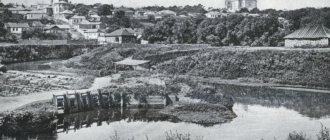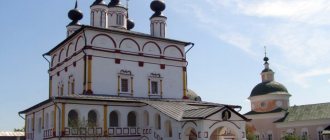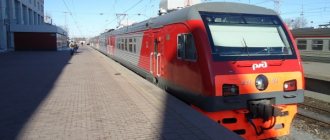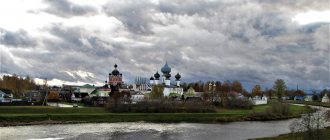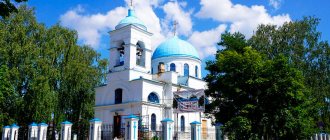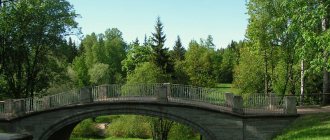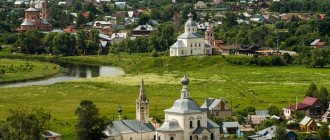One of the most picturesque cities in the Leningrad region is Vsevolozhsk. It arose on the site of a holiday village and a railway station built specifically for it. It received its name in honor of the founder Pavel Aleksandrovich Vsevolozhsky, who invested in the construction of the railway and became its shareholder. This place has always attracted St. Petersburg residents due to its nature, geographical location and special atmosphere. Pushkin visited here, once upon a time there was the first cheese factory of Catherine II, during the Second World War the “Road of Life” passed through - the only thread connecting the mainland with besieged Leningrad. Today Vsevolozhsk is an attractive tourist route. The city has comfortable hotels and restaurants with interesting cuisine. There are few attractions in the city itself. They can be viewed in one day. The main value is natural areas. The city, like a hundred years ago, is one of the best vacation spots in the Leningrad region. From St. Petersburg there is an electric train from the Finlyandsky Station (Irinovskoe direction), minibuses from the Ladozhskaya and Ploshchad Lenina metro stations.
The Legend of the Red Castle
The “Swedish trace” was not lost in the land of the future Vsevolozhsk. A road runs through the territory of Rumbolovsky Park, which old-timers called “Swedish bridges” - in memory of the gates laid back in the 16th century by the Swedish commander Pontus Delagardie. The ancient tract, of which only a small section remains in the park, went from Kexgolm (Priozersk) through Ruutunsky Pogost (Sosnovo) to Ryabovo (Vsevolozhsk) and then diverged into two: through Kelts (Koltushi) to Noteburg (Oreshek) and Nyenshantz (Cape at confluence of the Neva and Okhta). The mysterious structure, the ruins of which are preserved on the slope of Rumbolovskaya Mountain, most likely dates back to the time of Nyenschanz. People call it the “Red Castle”.
It is not that difficult to understand who built it. It is known that Russians have always built churches and estates on hills. But Scandinavians never settle on the peaks: their houses are usually located in a hollow, where it is easier to shelter from the cold winds. In Rumbolovsky Park all this found its expression: the manor house of the Vsevolozhsk princes (and, possibly, Fredericks) was built at the very top of the mountain, and the “Red Castle” stands on the slope.
Before the revolution, the practical owners of these places adapted the building into a “master building” and built their house on top (designed by the famous architect Pavel Schröter). The manor house burned down in 1928, but the more ancient “Red Castle” has survived to this day (albeit in terrible condition).
Once upon a time, Rumbolovskaya Mountain was a stronghold where Swedish troops could stop to rest on their way to Ingermanland and further to Muscovy. Apparently, for this purpose, a castle of five tiers with two towers was built in a semi-desert and swampy area. Under the walls of the castle, deep underground, there were giant cellars in which, if desired, supplies for a small army could be stored. For a secretive retreat, a system of underground passages was dug inside the mountain (which became a cult favorite for later enthusiastic explorers). The beginning of one of these underground passages is located in Rumbolovsky Park in the area of a large well. The well itself, located right next to the castle walls, is also impressive: its diameter is more than two meters, which also says a lot.
Needless to say, the cellars and underground passages of the old castle have not yet been explored in detail by anyone.
Links[edit]
Notes[edit]
- ^ abcdefgh Area Law No. 32-oz.
- ^ a b Federal State Statistics Service (2011). All-Russian Population Census 2010. Volume 1 [All-Russian Population Census 2010, vol. 1]. All-Russian Population Census 2010 [All-Russian Population Census 2010] (in Russian). Federal State Statistics Service.
- "26. The size of the permanent population of the Russian Federation by municipalities as of January 1, 2021". Federal State Statistics Service. Retrieved January 23, 2021.
- ^ abcde Law No. 17-ounce
- "On the Calculation of Time". Official Internet portal of legal information
. June 3, 2011. Retrieved January 19, 2021. - Post office. Information and computing center of OASU RPO. ( Post office
).
Search for postal service objects ( postal Search for objects
) (in Russian) - ↑
Federal State Statistics Service of Russia (May 21, 2004). The population of the Russian Federation, cities of the Russian Federation as part of federal districts, urban settlements, settlements, settlements, settlements is 3 thousand or more people. [Population of Russia, its federal districts , subjects of the Federation, districts, urban settlements, rural settlements - administrative centers and rural settlements with a population of more than 3000 people] (XLS). All-Russian Population Census of 2002 [All-Russian Population Census of 2002] (in Russian). - All-Union Population Census of 1989 Population of Union and Autonomous Republics, Autonomous Regions and Districts, Territories, Regions, Urban Settlements and Village District Centers [All-Union Population Census of 1989: Current Population of Union and Autonomous Republics, Autonomous Regions and Districts, Territories, Regions , districts, urban settlements and villages performing the functions of district administrative centers]. All-Union Population Census of 1989 [All-Union Population Census of 1989] (in Russian). Institute of Demography of the National Research University: Higher School of Economics [Institute of Demography of the National Research University: Higher School of Economics]. 1989 - via Demoscope Weekly
. - History (in Russian). Official website of the Municipal Municipality "City of Vsevolozhsk". Retrieved March 19, 2014.
- ^ a b Petrograd district (1917 - January 1924), Leningrad district (January 1924 - August 1927) (in Russian). System of classifiers of executive bodies of state power of St. Petersburg. Retrieved March 19, 2014.
- ^ a b c d Leninsky district of the Leningrad district (August 1927 - August 1930) (in Russian). System of classifiers of executive bodies of state power of St. Petersburg. Retrieved March 19, 2014.
- Leningrad region (in Russian). Handbook on the history of the Communist Party and the Soviet Union 1898 - 1991. Retrieved March 6, 2014.
- ^ a b Leningradsky Suburban District (August 1930 - August 1936) (in Russian). System of classifiers of executive bodies of state power of St. Petersburg. Retrieved March 19, 2014.
- ^ a b c Vsevolozhsk region (August 1936) (in Russian). System of classifiers of executive bodies of state power of St. Petersburg. Retrieved March 19, 2014.
- Report on the work of the committee for interaction with local government of the Leningrad region in 2010 (in Russian). Committee for Press and Public Relations of the Leningrad Region. Retrieved November 16, 2012.
- Monuments of history and culture of the peoples of the Russian Federation (in Russian). Ministry of Culture of Russia. Retrieved June 2, 2021.
- Vsevolozhsk State Museum of History and Local Lore (in Russian). Russian Cultural Heritage Network. Retrieved April 9, 2013.
- Literary and art museum-estate "Priyutino" (in Russian). Russian Cultural Heritage Network. Retrieved April 9, 2013.
Sources [edit]
- Legislative Assembly of the Leningrad Region. Regional Law No. 32-oz of June 15, 2010 “On the administrative-territorial structure of the Leningrad region and the procedure for changing it,” as amended. Regional Law No. 23-oz dated May 8, 2014 “On the merger of municipalities” Primorskoye urban settlement of the Vyborg district of the Leningrad region and Glebychevskoye rural settlement of the Vyborg district of the Leningrad region and on amendments to certain Regional laws. Came into force on the date of official publication. Published: “Vesti”, No. 112, June 23, 2010 (Legislative Assembly of the Leningrad Region. Regional Law of June 15, 2010 No. 32-oz “ On the administrative-territorial structure of the Leningrad Region and the procedure for changing it”
, As amended by the Regional Law dated 05/08/2014 No. 23-oz.
On the annexation of the municipalities "Urban settlement Primorskoye" in the Vyborg district of the Leningrad region and the "Glebychevskoye rural settlement" in the Vyborg district of the Leningrad region and on amendments to various regional laws
. Valid from the date of official publication.) . - Legislative Assembly of the Leningrad Region. Regional Law No. 17-oz of March 10, 2004 “On establishing boundaries and conferring statuses on the municipalities of Vsevolozhsk District and Vyborg District and the municipalities within them,” as amended. Regional Law No. 23-oz dated May 8, 2014 “On the merger of municipalities” Primorskoye urban settlement of the Vyborg district of the Leningrad region and Glebychevskoye rural settlement of the Vyborg district of the Leningrad region and on amendments to certain Regional laws. Came into force on the date of official publication. Published: “Vesti”, No. 27, March 11, 2004 (Legislative Assembly of the Leningrad Region. Regional Law No. 17-oz of March 10, 2004 On establishing boundaries and giving appropriate status to the municipalities of Vsevolozhsk and Vyborg districts and its constituent parts municipalities
as amended by Regional Law dated 05/08/2014 No. 23-oz “
On the annexation of the municipalities “Primorskoe urban settlement” in the Vyborg district of the Leningrad region and “Glebychevskoye rural settlement” in the Vyborg district of the Leningrad region and on amendments to various regional laws
. In force. from the date of official publication).
The city's attractions.
Since, it turns out, the city has quite a long and rich history, it, of course, has its own attractions: museums, architectural monuments and simply memorable places.
For example, in close proximity to the city there is the Priyutino estate - once its owner, A.N. Olenin, head of the Russian Academy of Arts, hosted the greatest representatives of our culture. Krylov, Venetsianov, Bryullov, Pushkin were here.
Now a museum exhibition is open here, and filmmakers often use the estate itself as a backdrop for filming. Vsevolozhsky’s manor house with a park has been preserved, only now it houses an agricultural technical school.
And the oldest existing building in the city is a cheese factory built in 1774, which was built on the initiative of the already mentioned Baron I. Yu. Fridriks.
There are also amazing ancient temples preserved in the city. The Church of the Savior Not Made by Hands and the Holy Trinity Church, for example, are considered architectural monuments of federal significance, and the Church of the Holy Trinity is a cultural and historical monument.
Relatively recently, several new churches were built: the Orthodox Church of St. Panteleimon (1996), the Orthodox Church of Saints Constantine and Helen (2001) and others.
There are several museums here: “Vsevolozhsk during the Siege”, the Museum of the History of Automobile Transport, and even the “Cat Museum”. Many memorials: “Rumbolovskaya Mountain” (part of the “Green Belt of Glory” monument complex), a monument to internationalist soldiers, liquidators of the Chernobyl nuclear power plant accident, soldiers who died in Chechnya, Heroes of the Second World War, the hero car - the “lorry”.
Economy
The city has a well-developed industry. At the same time, many large enterprises are located away from city blocks in the special industrial zone “Brick Factory” or in the communal and warehouse zone, although they do not pose a danger to residents and comply with international standards.
In the trade sector there are many shops, retail chains and shopping centers, and local entrepreneurs are also involved. The banking and insurance sectors and telecommunications are well developed. Very high rates of housing commissioning: this area is one of the leading in the Leningrad region. At the same time, the construction market is represented by a number of large companies.
With all this, the city is characterized by the so-called pendulum migration: many city residents work at enterprises in the region or even in St. Petersburg.
Bogoslovka Estate: description and opinion of tourists
This attraction will require a separate section. Its location is not entirely convenient. So it will take a certain amount of time to get there.
We are talking about the Bogoslovka Estate park complex, located in the Vsevolozhsk district. The park consists of several wooden buildings that show all the greatness of Russian architects. The beauty of the buildings so amazes everyone who visits this place that people are ready to return again and again. Not only the architecture, but also the pictures of nature, according to them, look simply amazing.
In this complex you will find a functioning church, a fortress and an ethnographic park, you will get a lot of pleasant impressions from what you see and will definitely understand those who praise this place so much.
Population dynamics
During the war years, by 1945, the population had almost halved to 6,296 people. Many people went to fight, some were evacuated deep into the country. In the first post-war years, the population of Vsevolozhsk increased rapidly; in 1959, 27,768 people lived in the city. In subsequent years, the number of residents continues to grow. In addition to natural growth, the population is increasing due to the large influx from other regions to the numerous newly opened new industries. In all subsequent years, only three cases of a slight decrease in the number of residents were noted.
Even in the difficult 90s for the whole country, the population of the city of Vsevolozhsk did not decrease. In the 2000s, thanks to the development of the automobile cluster in the Leningrad region, the number of residents continued to grow. For the first time it exceeded 60,000 people in 2012. The presence of a good offer of jobs and sufficient social protection for the population of Vsevolozhsk also attract people to the region. The ethnic composition of the residents is quite stable - Russians make up more than 90%, followed by Ukrainians and Belarusians. Ingrians live 92 people or 0.2%. In 2018, the population of Vsevolozhsk was 72,864 people.
Development of the region
Russian settlement of the region began after the triumphant victory in the Northern War of 1700-1721. Emperor Peter the Great began to grant the surrounding lands around the future capital to his particularly distinguished comrades. Carts with peasant families began to populate the donated lands from the central Russian regions, crowding out the local Finnish population. Among the population of Vsevolozhsk, the proportion of Russians gradually began to increase.
The territory of modern Vsevolozhsk began to be built up with noble manors (estate, estate in Finnish). Among the first to be built was the Ryabovo manor, whose owners at different times included the legendary Prince A. Menshikov and the banker I. Fredericks. Settlements have existed in the region since ancient times; the villages of Lubya, Ryabovo, Ryabovo Vladykino and Ryabovo Novoe in the valley of the Lubya River were mentioned in the “Census salary book of the Vodskaya Pyatina” of 1500. On maps of 1580 by the Swedish cartographer Pontus de la Gardie, the village of Lubya is marked in Karelia.
The Vsevolozhskys appeared in this region in 1818, when Ryabovo was bought by chamberlain Vsevolod Andreevich Vsevolozhsky. An old noble family owned the estate until 1917.
Further history
The railway was also built through the lands of Johann Bernhard; in January 1910, at his forgiveness, one of the stations was renamed “Bernhardovka”. Currently, this is the name of one of the city's microdistricts. Several more former narrow-gauge railway platforms entered Vsevolozhsk. By 1914, a hospital, two churches - Lutheran and Orthodox, and several schools were built in these settlements.
The status of a city was assigned to the village of Vsevolozhsky on February 1, 1963 by Decree of the Presidium of the Supreme Soviet of the RSFSR. It is on this day that the population of Vsevolozhsk celebrates the birthday of the city of Vsevolozhsk.
Why was the city named Vsevolozhsk?
The manor changed many owners until it was finally purchased by landowner P.A. Vsevolozhsky. Mr. Vsevolozhsky became one of the shareholders in the construction of the Irinovskaya narrow-gauge railway, passing directly through his lands. And this fact made it possible for the landowner to express his desire that one of the railway stations be named Vsevolozhskaya. This is how Pavel Alexandrovich Vsevolozhsky went down in history - he named the city Vsevolozhsk.
It was in 1892, this date is now considered to be the date of the founding of the city of Vsevolozhsk. Then the Ryabovo estate was inherited by Vasily Pavlovich Vsevolozhsky, the son of the old owner. He remained its owner until 1917. He was a progressive man, an advanced industrialist: he modernized peasant labor, organized agricultural exhibitions on his estate following the example of the Parisian one, and founded the St. Petersburg Automobile Club.
In addition, he was a trustee of orphanages, traveling as a doctor at any time of the day or night to the sick, no matter what their origin, which earned him universal respect. Under him, the station settlement, which by that time had become a dacha settlement, began to actively grow.
Then revolutionary changes in the country turned the station into a workers' settlement, the population of which continued to increase. And so, over time, a whole city grew up on this site.
And during the Great Patriotic War, the city of Vsevolozhsk was crossed by the same Road of Life, which did not allow besieged Leningrad to die from hunger and disease, because it at least partially connected the exhausted city with the mainland.
In 1963, the city of Vsevolozhsk finally received officially city status.



